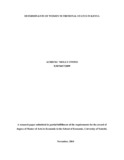| dc.description.abstract | Poor woman’s nutrition has negative consequences on her health and that of the entire family.
However, despite the central role that a woman plays in the health and well-being of members of
her household, little attention has been paid to her nutrition needs as other development
challenges have been viewed as more important. Available evidence from Demographic and
Health Surveys suggest deteriorating nutritional status.
This study used BMI for women as a measure of nutritional status. Both descriptive and
econometric techniques were employed. Probit analysis was applied after the proposed IVProbit
regression was considered inappropriate after endogeneity test carried out proved that
socioeconomic status was exogenous to women’s nutrition status. The results showed that factors
such as: place of residence; employment status; marital status; education level; age of the woman
and socioeconomic status are significant to undernutrition. Undernutrition was higher among
urban than rural. For overweight/ obesity, factors that turned out to be important determinants
include: employment status; marital status; education level; age of the woman; socioeconomic
status and type of toilet facility.
The study findings points to the need to implement a combination of policies to address
malnutrition. In combating undernutrition, there is need to: scale up social protection to target
urban poor women; carryout awareness creation on the importance of nutrition education among
women. Increasing education funding, strengthening and ensuring sustainability of free primary
and secondary education and ensuring completion/ retention among female students will help
reduce women undernutrition. The government also needs to fast truck slum upgrading
programme in the informal settlements as a long term solution to improve nutrition status. The
slum upgrading can help in the provision of publicly provided inputs to nutrition production such
as sewerage, portable water and electricity in these areas.
In dealing with overweight and obesity, this study suggests the need to establish policies that will
discourage aggressive marketing of junk food culture. National development policies should also
incorporate food, nutrition and lifestyle issues, with programmes that empower women to make
healthy dietary decisions, including the consumption of local foods and vegetables. There is also
need to incorporated dietary and healthy living topics in our education system as early as primary
level education. The suggested approaches require efforts both from government and nongovernment
actors for optimal results in alleviation of malnutrition among women in Kenyan | en_US |

